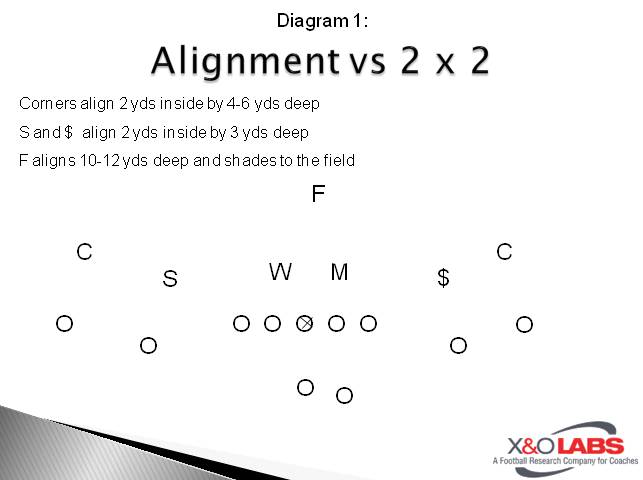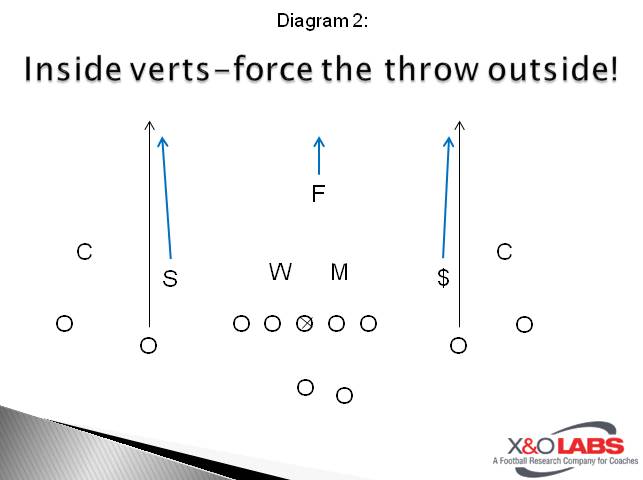By Jim Cancellari
Defensive Coordinator
John Jay High School (NY)
Introduction:
Offensive coordinators like to use formations and route combinations to get an advantage so we felt that combining man and zone responsibilities was our best answer for handling shifts, motions, and the various route combos that spread teams are now running. We start by teaching our players in “if-than” scenarios and pattern reading and combining man and zone principles in our coverage. We teach our defenders that receivers can really only do one of three things on pass plays. They can go inside, they can go outside or they can go vertical. Our coverage system is all about teaching the corners, the OLBs, and the free safety how to react when their receiver does one of these three things.
Base Concept:
Our base alignment to any 2x2 formation is a 1 high look (Diagram 1). We play all defenders in an inside alignment because we want to force long throws to the outside. Our OLBs are 2 yards inside and 3 yards deep of any split inside receiver. They will be 2x3 to the outside if #2 is a TE. Our corners play at a depth of 6 yards and are shaded 2 yards inside and looking in at the near tackle for their run/pass read. The free safety is aligned over the field side guard at a depth of 10-12 yds. We may play with his depth or width depending on the situation but this is our starting point.

SOLO COVERAGE is our 1 high coverage.
SOLO starts as a man-free Cover 1 concept. We want to give our free help versus inside vertical routes. Responsibilities in this coverage are as follows:
Outside Linebackers: They have #2 on everything except shallow crossing routes. They must pass crossers off to the ILBs and get depth, looking for a crossing route coming back at them. They must make a “CROSSER” call. Help on any deep crossing routes. They are responsible to fight across any blockers and be the first defender to any WR screen.
Cornerbacks: Expect to play the receiver man to man on every route. If #1 runs a post, he must make eye contact with the FS. If the FS gives you a "CUT" call, zone turn deep to the outside looking to get over the top of a wheel route. If no "CUT" call is given, continue to run with the post route. If he sees #1 run a Screen, he must make a "SCREEN" call as loud as possible and play deep for any tricks plays off the screen. Once the ball is in the air, he can rally to the screen late.
Free Safety: He is making his run/pass read off the guards. If he gets a pass read, he will read QB's eyes and scan the field while getting depth. If a post is coming at him, he must peek to the #2 receiver on that side to check for a post-wheel combo. If there is a post-wheel combo, he must make a "CUT" call alerting the corner to zone turn to the wheel and the FS will then play the post route. If there is no post-wheel combo, he is responsible for the deep middle helping out on any crossing routes deeper than 8 yards.
Applying the Free's Rule:
Once our free reads pass, he starts his rule by getting his eyes to #2 to the field. #2 can do 1 of 3 things. He can release inside (like a mesh route), he can release vertically (like a hitch or a go route) or he can release to the flat (like a slide route or a bubble route).
If the Free sees #2 go to the flat:
We teach the free to snap his eyes to #1. If #1 is running towards him, he will make a “CUT” call to the corner. This tells the corner that the FS will take over #1 and the corner must get back to the deep third. The biggest coaching point is to get the free to recognize post-wheel as quickly as possible so he can make his “CUT” call early and release the corner. We tell our free if he doesn’t like the angle #1 is running or if the corner is running parallel to the LOS, he can get over top of #2 if he wheels.
If the Free sees #2 go verticle:
If #2 is climbing vertical, the free must continue to get depth and peek at #2 weak. This tells him if he is getting inside vertical routes. Our free will try to stay in between both inside verticals and react to the ball when it is in the air, he cannot be moved by the QBs eyes. (Diagram 2)










